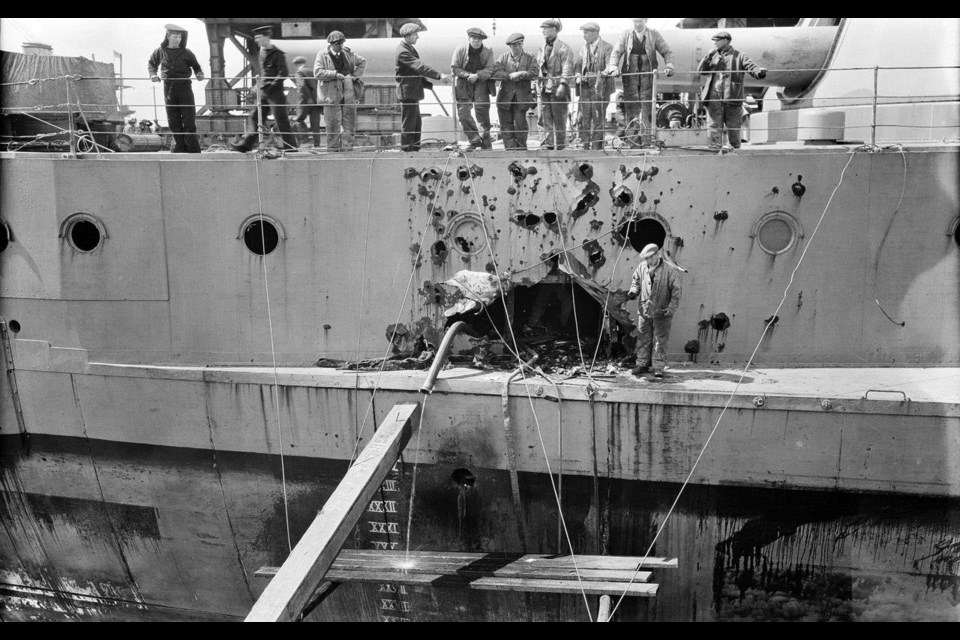KANANASKIS – When you look around at the mountain peaks of the Bow Valley, there are many names that are familiar to locals and residents alike.
Nestled away in the backcountry though, several mountains highlight and celebrate the First World War history of Canada and the British Empire. Among those mountains are a series of peaks that honour the ships of the Battle of Jutland.
Unlike the Second World War, when sea battles played a major part, this battle was one of the few fought during the First World War. Lasting for only two days from May 31 to June 1, 1916, it involved 151 combat ships on the British side and 99 combat ships on the German side.
It was also, by all accounts, a blood bath on the waves.
“The ships of the grand fleet went into action as if they were going to maneuvers. From every yard arm, the white ensign flew, the flag which is to the sailor as the tattered colors were in days of old to a hard pressed regiment,” an officer in the battle said. “They have fought a great fight, a fight to be proud of, a fight which will live longer than many a victory.”
By the end of the battle, nearly 9,000 men had died, 1,000 were injured and over a dozen ships were sent below the waves, three of which have been honoured in Kananaskis.
Rising to 2,667 metres, there is Mount Indefatigable, which is visible from Highway 40 and Kananaskis Lakes. The mountain received its name in 1917 in honour of the HMS Indefatigable. During the battle on May 31, the ship was hit by a series of German shells that quickly ruptured its hull. Of the 1,019 crew, only three survived. The mountain was first climbed in 1901 by Water D. Wilcox but its trail to the summit is now closed as the area is prime grizzly bear habitat.
For hikers, there was a running joke about the mountain and the difficulty of the hike.
“Do you guys know what mountain that is?” a guide would ask.
The response was invariably that it was Mount Uncomfortable.
Located next to Mount Indefatigable is Mount Invincible, rising to 2,700 metres. This peak is named for the HMS Invincible, which was the first battlecruiser built by any country in the world when it was launched on April 13, 1907. Through the war, the ship had seen action at the Battle of Heligoland Blight and the Battle of the Falkland Islands. In each battle, she survived with nearly no loss of life.
During the Battle of Jutland, she was the flagship of the Third Battlecruiser Squadron. On May 31, 1916, her luck ran out and she was hit by three salvos from two German ships. One shell ignited the midship magazine and the explosion of that magazine tore the ship into two pieces. She sunk beneath the waves within only 90 seconds, killing 1,026 officers and men, with only six surviving in the water where they were picked up by the HMS Badger. All six had been thrown clear of the ship in the explosion.
Among the dead was Rear Admiral Horace Hood.
“Hood led the division into action with the most inspiring courage,” Vice Admiral Beatty said shortly after the battle.
Mount Invincible was first climbed in 1957.
Located next to Mount Invincible, and rising slightly higher, is Mount Warspite at 2,860 metres high. One of five Queen Elizabeth-class battleships built for the Royal Navy during the early 1910s, she was part of the Grand Fleet that took part in the Battle of Jutland. Unlike the other two ships, she survived the battle despite being hit 15 times. Of her crew, 14 were killed and 16 were wounded.
One wounded officer was Walter Yeo, who became one of the first men to have his face reconstructed using plastic surgery. Surviving the war, HMS Warspite served in the Second World War as part of the Eastern Fleet in the Indian Ocean. The Warspite also took part in the Normandy landings in 1944. By the time she was decommissioned on Feb. 1, 1945, she was called the Grand Old Lady and had received more battle honours than any individual ship in the Royal Navy.
Lastly, next to Mount Warspite is the tallest of the four mountains, Mount Black Prince. Rising to 2,939 metres, this mountain’s name honours the HMS Black Prince.
Built in 1903, the ship was part of the Mediterranean Fleet at the start of the First World War, before going to the North Sea where she would have her date with destiny as part of the Battle of Jutland.
During the battle on May 31, the ship simply disappeared from view and no one knew what had happened to her. No one saw her be destroyed and it was not known if she was sunk by a submarine or surface ship. The last message over the wireless from her crew was to relay that they had sighted a submarine. The HMS Spitfire stated in reports what it thought was a German ship with flames consuming its entire deck, but today it is believed to have been the Black Prince. All 857 of its crew were lost in the sinking.




